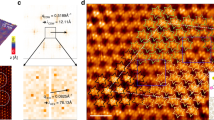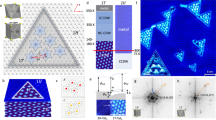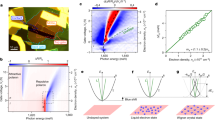Abstract
A dilute system of electrons interacting through long-range Coulomb forces has been predicted to form a periodic solid known as a Wigner crystal. To date, this state has been observed directly only in two-dimensional systems. Here, using low-temperature single-electron transport spectroscopy, we show that the hole gas in low-disorder semiconducting carbon nanotubes forms a one-dimensional Wigner crystal. In an axial magnetic field, we observe three distinct regimes of spin and isospin polarization as carrier density is varied. We explain these regimes in terms of a Wigner crystal picture based on a gapped Luttinger liquid model, with the carriers represented by spatially localized solitons. Our observations could enable greater control over the behaviour of the spatially separated system of carriers. Such control, combined with the inherently long coherence times of carriers in carbon nanotubes, could prove useful in the development of solid-state quantum computing.
This is a preview of subscription content, access via your institution
Access options
Subscribe to this journal
Receive 12 print issues and online access
$209.00 per year
only $17.42 per issue
Buy this article
- Purchase on Springer Link
- Instant access to full article PDF
Prices may be subject to local taxes which are calculated during checkout




Similar content being viewed by others
References
Fisher, M. P. A. & Glazman, L. I. Mesoscopic Electron Transport (Kluwer Academic, Boston, 1997).
Chang, A. M. Chiral Luttinger liquids at the fractional quantum Hall edge. Rev. Mod. Phys. 75, 1449–1505 (2003).
Bockrath, M. et al. Luttinger-liquid behaviour in carbon nanotubes. Nature 397, 598–601 (1999).
Yao, Z., Postma, H. W. C., Balents, L. & Dekker, C. Carbon nanotube intramolecular junctions. Nature 402, 273–276 (1999).
Schwartz, A. et al. On-chain electrodynamics of metallic (TMTSF)2X salts: Observation of Tomonaga–Luttinger liquid response. Phys. Rev. B 58, 1261–1271 (1998).
Auslaender, O. M. et al. Tunneling spectroscopy of the elementary excitations in a one-dimensional wire. Science 295, 825–828 (2002).
Wigner, E. On the interaction of electrons in metals. Phys. Rev. 46, 1002–1011 (1934).
Schulz, H. J. Wigner crystal in one dimension. Phys. Rev. Lett. 71, 1864–1867 (1993).
Matveev, K. A. Conductance of a quantum wire in the Wigner-crystal regime. Phys. Rev. Lett. 92, 106801 (2004).
Fiete, G. A., Le Hur, K. & Balents, L. Transport in a spin-incoherent Luttinger liquid. Phys. Rev. B 72, 125416 (2005).
Fogler, M. M. & Pivovarov, E. Exchange interaction in quantum rings and wires in the Wigner-crystal limit. Phys. Rev. B 72, 195344 (2005).
Kindermann, M., Brouwer, P. W. & Millis, A. J. Interference as a probe of spin incoherence in strongly interacting quantum wires. Phys. Rev. Lett. 97, 036809 (2006).
Steinberg, H. et al. Localization transition in a ballistic quantum wire. Phys. Rev. B 73, 113307 (2006).
Yamamoto, M., Stopa, M., Tokura, Y., Hirayama, Y. & Tarucha, S. Negative Coulomb drag in a one-dimensional wire. Science 313, 204–207 (2006).
Liang, W., Bockrath, M. & Park, H. Shell filling and exchange coupling in metallic single-walled carbon nanotubes. Phys. Rev. Lett. 88, 126801 (2002).
Sapmaz, S. et al. Electronic excitation spectrum of metallic carbon nanotubes. Phys. Rev. B 71, 153402 (2005).
Nygard, J., Cobden, D. H. & Lindelof, P. E. Kondo physics in carbon nanotubes. Nature 408, 342–346 (2000).
Jarillo-Herrero, P., Sapmaz, S., Dekker, C., Kouwenhoven, L. P. & van der Zant, H. S. J. Electron–hole symmetry in a semiconducting carbon nanotube quantum dot. Nature 429, 389–392 (2004).
Minot, E. D., Yaish, Y., Sazonova, V. & McEuen, P. L. Determination of electron orbital magnetic moments in carbon nanotubes. Nature 428, 536–539 (2004).
Cao, J., Wang, Q. & Dai, H. Electron transport in very clean, as-grown suspended carbon nanotubes. Nature Mater. 4, 745–749 (2005).
Levitov, L. S. & Tsvelik, A. M. Narrow-gap Luttinger liquid in carbon nanotubes. Phys. Rev. Lett. 90, 016401 (2003).
Novikov, D. S. Electron properties of carbon nanotubes in a periodic potential. Phys. Rev. B 72, 235428 (2005).
McEuen, P., Bockrath, M., Cobden, D., Yoon, Y.-G. & Louie, S. Disorder, pseudospins, and backscattering in carbon nanotubes. Phys. Rev. Lett. 83, 5098–5101 (1999).
Cobden, D. H., Bockrath, M., McEuen, P. L., Rinzler, A. G. & Smalley, R. E. Spin splitting and even–odd effects in carbon nanotubes. Phys. Rev. Lett. 81, 681–684 (1998).
Matveev, K. A. Conductance of a quantum wire at low electron density. Phys. Rev. B 70, 245319 (2004).
Klironomos, A. D., Ramazashvili, R. R. & Matveev, K. A. Exchange coupling in a one-dimensional Wigner crystal. Phys. Rev. B 72, 195343 (2005).
Oreg, Y., Byczuk, K. & Halperin, B. I. Spin configurations of a carbon nanotube in a nonuniform external potential. Phys. Rev. Lett. 85, 365–368 (2000).
Goldhaber-Gordon, D. et al. Kondo effect in a single-electron transistor. Nature 391, 156–159 (1998).
Zitko, R., Bonca, J., Ramsak, A. & Rejec, T. Kondo effect in triple quantum dots. Phys. Rev. B 73, 153307 (2006).
Jarillo-Herrero, P. et al. Orbital Kondo effect in carbon nanotubes. Nature 434, 484–488 (2005).
Sasaki, S. et al. Kondo effect in an integer-spin quantum dot. Nature 405, 764–767 (2000).
Javey, A., Guo, J., Wang, Q., Lundstrom, M. & Dai, H. J. Ballistic carbon nanotube field-effect transistors. Nature 424, 654–657 (2003).
Kong, J., Soh, H. T., Cassell, A. M., Quate, C. F. & Dai, H. Synthesis of individual single-walled carbon nanotubes on patterned silicon wafers. Nature 395, 878–881 (1998).
Pop, E. et al. Negative differential conductance and hot phonons in suspended nanotube molecular wires. Phys. Rev. Lett. 95, 155505 (2005).
Acknowledgements
We acknowledge Micro Nano Laboratory at Caltech and Nanotech at UCSB, where fabrication was carried out. We thank C. N. Lau, G. Fiete, G. Refael, R. Barnett, D. Novikov, P. Jarillo-Herrero, C. Marcus, B. Muralidharan and H. Van der Zant for discussions. We acknowledge the support of the Office of Naval Research and the Sloan foundation. We thank an anonymous referee for raising the question concerning the observability of the Kondo effect in our system.
Author information
Authors and Affiliations
Corresponding author
Supplementary information
Supplementary Information
Supplementary Discussion and Supplementary Figure 1–3 (PDF 393 kb)
Rights and permissions
About this article
Cite this article
Deshpande, V., Bockrath, M. The one-dimensional Wigner crystal in carbon nanotubes. Nature Phys 4, 314–318 (2008). https://doi.org/10.1038/nphys895
Received:
Accepted:
Published:
Issue Date:
DOI: https://doi.org/10.1038/nphys895
This article is cited by
-
Nano-assembled open quantum dot nanotube devices
Communications Materials (2024)
-
Wigner crystallization in quasi-one-dimensional quantum wire
Discover Materials (2023)
-
Tunneling between parallel one-dimensional Wigner crystals
Scientific Reports (2022)
-
Asymmetric Wigner molecules in nanowire Y-junctions
Scientific Reports (2022)
-
Imaging two-dimensional generalized Wigner crystals
Nature (2021)



